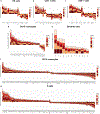A single-cell atlas of the peripheral immune response in patients with severe COVID-19
- PMID: 32514174
- PMCID: PMC7382903
- DOI: 10.1038/s41591-020-0944-y
A single-cell atlas of the peripheral immune response in patients with severe COVID-19
Abstract
There is an urgent need to better understand the pathophysiology of Coronavirus disease 2019 (COVID-19), the global pandemic caused by SARS-CoV-2, which has infected more than three million people worldwide1. Approximately 20% of patients with COVID-19 develop severe disease and 5% of patients require intensive care2. Severe disease has been associated with changes in peripheral immune activity, including increased levels of pro-inflammatory cytokines3,4 that may be produced by a subset of inflammatory monocytes5,6, lymphopenia7,8 and T cell exhaustion9,10. To elucidate pathways in peripheral immune cells that might lead to immunopathology or protective immunity in severe COVID-19, we applied single-cell RNA sequencing (scRNA-seq) to profile peripheral blood mononuclear cells (PBMCs) from seven patients hospitalized for COVID-19, four of whom had acute respiratory distress syndrome, and six healthy controls. We identify reconfiguration of peripheral immune cell phenotype in COVID-19, including a heterogeneous interferon-stimulated gene signature, HLA class II downregulation and a developing neutrophil population that appears closely related to plasmablasts appearing in patients with acute respiratory failure requiring mechanical ventilation. Importantly, we found that peripheral monocytes and lymphocytes do not express substantial amounts of pro-inflammatory cytokines. Collectively, we provide a cell atlas of the peripheral immune response to severe COVID-19.
Conflict of interest statement
Competing interests
The authors declare no competing interests.
Figures














Update of
-
A single-cell atlas of the peripheral immune response to severe COVID-19.medRxiv [Preprint]. 2020 Apr 23:2020.04.17.20069930. doi: 10.1101/2020.04.17.20069930. medRxiv. 2020. Update in: Nat Med. 2020 Jul;26(7):1070-1076. doi: 10.1038/s41591-020-0944-y. PMID: 32511639 Free PMC article. Updated. Preprint.
References
-
- Wu Z & McGoogan JM Characteristics of and important lessons from the coronavirus disease 2019 (COVID-19) outbreak in China: summary of a report of 72314 cases from the Chinese Center for Disease Control and Prevention. JAMA 323, 1239–1242 (2020). - PubMed
Publication types
MeSH terms
Substances
Grants and funding
- DGE-1656518/National Science Foundation (NSF)/International
- DP1 DA04608902/U.S. Department of Health & Human Services | NIH | National Institute on Drug Abuse (NIDA)/International
- T32 GM007365/GM/NIGMS NIH HHS/United States
- DP1 DA046089/DA/NIDA NIH HHS/United States
- R25 GM086262/GM/NIGMS NIH HHS/United States
- AI007290-35/U.S. Department of Health & Human Services | National Institutes of Health (NIH)/International
- 1016687/Burroughs Wellcome Fund (BWF)/International
- T32 AI007502/AI/NIAID NIH HHS/United States
- T32 AI007290/AI/NIAID NIH HHS/United States
- T32 GM007365-44/U.S. Department of Health & Human Services | National Institutes of Health (NIH)/International
- K23 HL125663/HL/NHLBI NIH HHS/United States
- T32 AI007502-23/U.S. Department of Health & Human Services | National Institutes of Health (NIH)/International
- WT_/Wellcome Trust/United Kingdom
LinkOut - more resources
Full Text Sources
Other Literature Sources
Molecular Biology Databases
Research Materials
Miscellaneous

